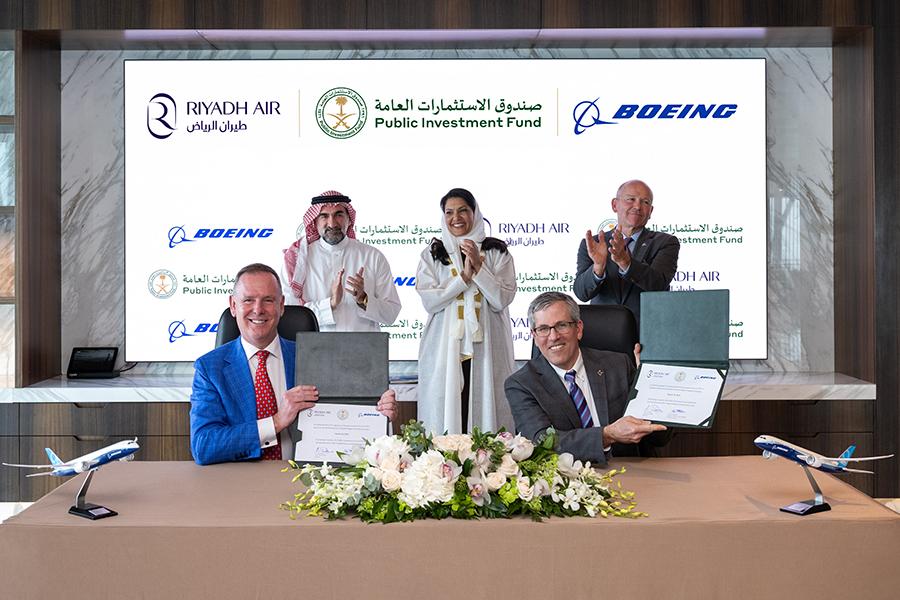
Riyadh Air CEO Tony Douglas (left) and Boeing SVP Commercial Sales and Marketing Brad McMullen (second right) hold up signed contracts as PIF's governor Yasir AlRumayyan (second left), Saudi Arabia's U.S. Ambassador Princess Reema Al Saud (center) and Boeing CEO Dave Calhoun (right) applaud.
This week’s top air transport stories come out of Saudia Arabia as Saudia and newly launched Riyadh Air placed mega orders for Boeing 787 aircraft, just days before Kuwait-based Jazeera Airways announced plans to establish a Dammam-based LCC subsidiary.
Saudi Arabian state-owned carriers Saudia and newly launched Riyadh Air placed orders for up to a combined 121 Boeing 787s. Riyadh Air—which was unveiled March 12 by crown prince Mohammad bin Salman who also appointed former Etihad Airways Group CEO Tony Douglas as CEO—will purchase 39 787-9s for its global launch (TBA), with options for an additional 33 787-9s. Saudia will purchase 39 with a further 10 options. The agreement will include both 787-9 and 787-10s.
Kuwait-based LCC Jazeera Airways plans to establish a Saudi Arabian subsidiary based in Dammam. The carrier said in a March 14 statement that it would be launching an LCC that would complement Saudi Arabia’s “Vision 2030,” which aims to diversify the kingdom’s economy away from oil and into areas such as tourism and aviation. Jazeera Airways is working with Saudi partners on the new venture, which will be based at King Fahad International Airport in Dammam, a port city on the Persian Gulf. No further details on the new venture were released. Coordination is underway between Jazeera and the Saudi Arabian regulatory authorities to obtain the necessary licenses.
Meanwhile, EgyptAir subsidiary Air Cairo and Turkish Airlines/Lufthansa’s joint venture SunExpress plan to extend their partnership launched in May 2021. For the upcoming summer, Air Cairo will operate around 87 weekly flights from 15 airports in Austria, Germany and Switzerland to Egypt’s Red Sea resorts of Hurghada, Marsa Alam and Sharm El Sheikh. Air Cairo will operate the majority of the flights, while SunExpress provides its market expertise. Both airlines plan to offer passengers access to Air Cairo’s domestic route network of over 300 weekly flights, which include both connecting and domestic flights.
In merger news, Transport Canada approved Calgary-based WestJet Group’s acquisition of Sunwing Vacations and Sunwing Airlines.
In Asia, All Nippon Airways’ (ANA) proposed subsidiary carrier AirJapan is scheduled to begin service in February 2024. The new carrier will conduct medium-haul international flights with a different business model than the full-service ANA offering.
In North America, United Airlines is still bullish about the current revenue environment—despite forecasting a loss for the 2023 first quarter—and believes its assessment of challenges facing the industry remains valid. The Chicago-based airline has revised its projections from a profit of 50 cents to $1 per share for the quarter to a loss of 60 cents to $1. United also adjusted its forecast total unit revenue growth to 22% to 23% year-over-year, down from an initially estimated 25% increase. In a regulatory filing, United explained it was seeing “new seasonal demand patterns,” and weaker months January and February were “growing less than high demand months.”
Southwest Airlines is “well underway” with a remediation plan to prevent a winter event of the magnitude and impact of its December 2022 operational disruption, including through investments in technology, equipment and cross-team collaboration. The carrier continues to estimate a first-quarter negative revenue impact of roughly $300-350 million related to the “bookaway” that followed its disruption, which came during the busy winter holiday travel period. With that impact largely isolated to January and February, CEO Bob Jordan called March revenue trends “encouraging” alongside several upward-trending engagement metrics he said were remaining steady.
Canadian ULCC Flair Airlines is working to meet its capacity targets for the busy summer travel season after lessor Airborne seized four Boeing 737 MAX aircraft from the airline. The seizure took place on March 11, but the airline has returned to a full schedule “because we had three [Boeing 737] MAX aircraft already in the airline, but waiting for the summer period,” Flair CEO Stephen Jones said during a March 14 media briefing. During late 2022, Flair had a fleet of 22 aircraft, 19 Boeing 737-8s and three 737-800s.
On the manufacturing side, Boeing’s delivery totals dipped in February as an expected slowdown in 737 activity was exacerbated by unanticipated hold-ups on two widebody programs. Customers took 28 total aircraft in February, including 25 737s. One was a P-8 for New Zealand, and the rest were 737 MAXs. The 24 737 MAX handovers, down from 35 in January, align with Boeing’s public projections that have deliveries starting slow before ramping up in the second half of the year for a total of 400-450. Airbus delivered 46 aircraft (three A220s; 39 A320neo; two A330s; two A350s) in February vs 49 in February 2022; it booked orders from unidentified customers for 15 A320neos and an ACJ319neo.
Finally, in one of the final steps toward the full reopening of the world’s second-largest air transport market, China restarted issuing all visa types to foreign tourists on March 15, just over three years since the World Health Organization (WHO) classified COVID-19 as a global health crisis. The move also comes after the lifting of testing requirements from countries such as South Korea and the US Center for Disease Control (CDC).



